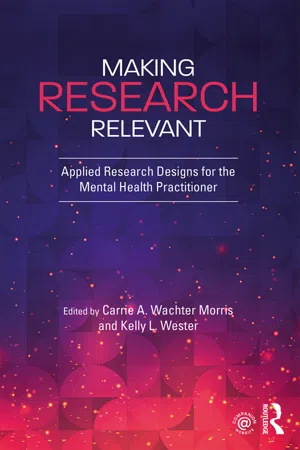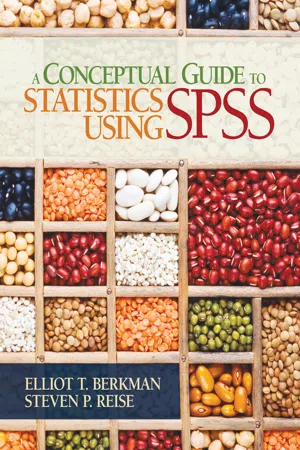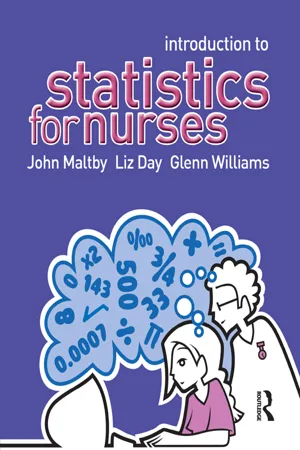Correlation
Correlation in psychology refers to the statistical relationship between two or more variables. It measures the extent to which changes in one variable are associated with changes in another. A positive correlation indicates that as one variable increases, the other also increases, while a negative correlation suggests that as one variable increases, the other decreases.
7 Key excerpts on "Correlation"
- eBook - ePub
- Hugh Coolican(Author)
- 2018(Publication Date)
- Routledge(Publisher)
...Effect size and power are considered for Correlations. Important points about Correlations are: Cause cannot be inferred from the existence of a strong Correlation between two variables. Strength is a measure of the Correlation but significance assesses how unlikely such a Correlation was to occur under the null hypothesis (usually that the population Correlation is zero). This assessment depends on the size of N. Sampling weaknesses may artificially increase or decrease a Correlation coefficient – one particular phenomenon is the restriction of range caused by only correlating scores for certain categories of people, often only those available. Correlations for dichotomous variables are covered briefly (point biserial Correlation, biserial Correlation and the phi coefficient). Common uses of Correlation in psychology are: non-experimental studies on two measured variables, reliability testing of scales, tests and questionnaires, factor analysis and twin studies. SPSS procedures for Correlation are provided. Key Term Correlation A (standardised) measure of relationship of co-variance between two variables. Positive Correlation Correlation where, as values of one variable increase, related values of another variable also tend to increase. Negative Correlation Correlation where, as values of one variable increase, related values of another variable tend to decrease. The nature of simple Correlation Positive and negative Correlations Have a look at the following statements: 1 The older I get, the fewer things I remember. 2 The more you give kids, the more they expect. 3 The taller people are, the more successful they are in their careers. 4 The more physical punishment children receive, the more aggressive they become when they’re...
- eBook - ePub
Statistics in Social Work
An Introduction to Practical Applications
- Amy Batchelor(Author)
- 2019(Publication Date)
- Columbia University Press(Publisher)
...5 THE STATISTICS OF RELATIONSHIPS A nalyzing relationships between variables that affect people is as important as analyzing relationships between people. Correlational methods help you better understand people, communities, and policy. If you are interested in what protective factors might help develop resilience in your client, Correlations help with that. If you have ever wondered whether a person’s income can help predict school outcomes for their children, Correlations help with that too. Or if you have ever wondered whether older adults who are lonely are more likely to experience poor health outcomes, Correlations can provide useful context there too. The relationships between these variables affect the people you work with, and Correlations help you analyze variables more effectively. LEARNING OBJECTIVES By the end of this chapter, you should understand the following concepts: • What Correlation is (and is not) • How to determine the strength and direction of a Correlation based on Pearson’s r • How to use the coefficient of determination • How to read scattergrams and Correlation tables Correlation Correlation is the statistical analysis that describes the strength and direction of a relationship between variables. As discussed in chapter 1, in your practice, you might hope that by increasing the number of counseling sessions a client attends (variable X), you will increase the reported happiness of your client (variable Y). Understanding how one variable is related to another is at the heart of your practice, regardless of the specific context you work in or the population you work with. You must always remember that even strong Correlations do not mean one variable caused the variation you see in the other. Correlation is not causation...
- eBook - ePub
- S Alexander Haslam, Craig McGarty(Authors)
- 2018(Publication Date)
- SAGE Publications Ltd(Publisher)
...9 Examining Relationships between Variables: Correlation Key goals for this chapter Introduce Correlation – a procedure for examining relationships between variables. Introduce Pearson’s r – a statistic that quantifies the nature and strength of the linear relationship between two variables. Explain how the results of Correlational analysis should be interpreted, with particular reference to the difference between Correlation and causation. A lot of what we have talked about in the previous two chapters relates to comparisons between means, and comparing means is what psychologists typically do when they use experimental methodology. However, in a great deal of research investigators confront another interesting question: What is the relationship between two variables? For example, how is stress related to heart disease? How is socio-economic status related to mental health? How is personality related to the judgements people make? This type of question can be addressed by experiments (as in the previous chapter, where we used an example of the relationship between the amount of physical contact and attraction), but is more typically examined in surveys. In surveys the researchers collect information about variables where there may be many different values for each variable (in the attraction study, for example, lots of different levels of contact, not just two, and lots of different levels of attraction). Surveys also often measure two or more variables, each with multiple levels. We can contrast this with the case of a t- test where we have an independent variable with just two levels (a categorical variable) and a dependent variable with multiple levels. In survey research we often want to know whether two variables vary together...
- eBook - ePub
Making Research Relevant
Applied Research Designs for the Mental Health Practitioner
- Kelly L. Wester, Carrie A. Wachter Morris, Carrie A. Wachter Morris, Kelly L. Wester(Authors)
- 2018(Publication Date)
- Routledge(Publisher)
...For a positive relationship, as one variable increases, the other variable increases as well. For a negative relationship, as one variable increases, the other variable decreases. The results of a Correlational design can only inform researcher about the relationship, but the results do not infer causality of the relationship. In other words, a Correlation would not imply that one variable causes another variable but rather would describe the relationship between the two. Figure 7.1 Examples of Correlations Note: (a) no Correlation, (b) strong positive Correlation, (c) strong negative Correlation Data Analysis: Causal-Comparative Research Design Descriptive Statistics Descriptive statistics are used to describe your data. Typically, these statistics include the mean, mode, and median for your groups. For example, when conducting a causal-comparative study, you are testing whether there is a difference in the mean scores of each of your groups. In the case of the present example, you would test whether there is a difference in the mean scores of social support and anxiety between male and female clients. Descriptive statistics do not typically allow you to draw inferences or conclusions based on the mean scores but simply provide you a visual of whether one group is, on average, greater or less than another group. Inferential Statistics Inferential statistics are used in a causal-comparative research to demonstrate a relation between your independent and dependent variables (Brewer & Kubn, 2012). Unlike descriptive statistics, inferential statistics allow you to make inferences, or conclusions, about your results...
- eBook - ePub
- Alan J. Cann(Author)
- 2013(Publication Date)
- Wiley(Publisher)
...If you swap the two variables, you will obtain a different regression line. In contrast, Correlation calculations are symmetrical with respect to X and Y. If you swap the labels X and Y, you will still get the same Correlation coefficient. 11.2. Correlation Correlation, the relationship between two variables, is closely related to prediction. The greater the association between variables, the more accurately we can predict the outcome of events which have not yet happened. In biology, of all subjects, there is rarely an exact Correlation of observed results with a mathematical function – the points never fit exactly on the line. The question is therefore whether an association between two variables could have occurred by chance. There are numerous methods for calculating Correlation, for example: 1. The Pearson, or ‘ r -value’, Correlation (parametric). Calculate the Pearson Correlation coefficient if you know or can assume that both X and Y are interval data sampled from normally distributed populations. However, with large samples, the frequency distribution of the population is less important. Correlation is greatly affected by sample size. With very large samples small Correlation coefficients will be statistically significant, but with small samples only very high Correlations will reach statistical significance. 2. The Spearman (rank-order) Correlation (non-parametric). Calculate the Spearman Correlation coefficient if X or Y are ordinal or ranked-data. The Spearman Correlation is based on ranking the two variables, and so makes no assumption about the distribution of the values and is usually calculated on occasions when it is not convenient, economic or even possible to give actual values to variables, but only to assign a rank order to instances of each variable. It may also be a better indicator that a relationship exists between two variables when the relationship between them is non-linear. 3...
- eBook - ePub
- Elliot T. Berkman, Steven P. Reise(Authors)
- 2011(Publication Date)
- SAGE Publications, Inc(Publisher)
...4 Correlation CHAPTER OUTLINE Behind the Scenes: Conceptual Background of Correlation Covariance Versus Correlation Computing Correlation (and Covariance) in SPSS Interpreting the Correlation Output A Closer Look: Partial Correlations Visualizing Correlations BEHIND THE SCENES: CONCEPTUAL BACKGROUND OF Correlation Correlation has many definitions, and we’ll give you a few different ones, but the only one that you really need to know is this: the degree of the linear relationship between two variables. One reason people often get confused about Correlation is that the equation used to compute it has no intuitive relationship to the conceptual meaning of “linear relationship between two variables.” So we will begin this chapter by providing (or at least attempting to provide) an intuitive explanation of how the formula for a Correlation coefficient relates to the concept of a Correlation. To do this, it is helpful to first understand covariance. In class or in your textbook, you may have learned that the covariance between two variables, X and Y, is defined as COV (X, Y) = E (XY) − E (X) E (Y), where In English, this says that the covariance between X and Y is the difference between the expected value of their products and the product of their expected values. In order to simplify this, suppose for now that both X and Y are centered around 0 (i.e., we have subtracted the mean from each observation). Furthermore, suppose that X and Y are distributed symmetrically around the (zero) mean. Now, look again at the equations for E (X) and E (Y). These quantities are the sum of the products of each value with its probability. Under the assumptions that we made (observations are centered symmetrically around the zero mean), each positive value in the distribution is mirrored by a negative value, and each has the same probability of appearing in a sample...
- eBook - ePub
- John Maltby, Liz Day, Glenn Williams(Authors)
- 2014(Publication Date)
- Routledge(Publisher)
...The Correlation coefficient provides a statistic that tells us the direction, the strength and the significance of the relationship between two variables. What do we mean by direction and strength? Well, both the Pearson and Spearman Correlation statistics use the number of the data and present a final figure that indicates the direction and strength of the relationship. This final figure is always known as the Correlation coefficient and is represented by r (Pearson) or rho (Spearman). The Correlation coefficient will always be a value ranging from +1.00 through 0.00 to −1.00. A Correlation of +1.00 would be a ‘perfect’ positive relationship. A Correlation of −1.00 would be a ‘perfect’ negative relationship. A Correlation of 0.00 would be no relationship (no single straight line can sum up the almost random distribution of points). All Correlations, then, will range from −1.00 to +1.00. So a Correlation statistic could be −0.43 (a negative relationship) or 0.53 (a positive relationship). It could be 0.01, close to no relationship. This figure can then be used with significance testing, such as the chi-square, to see whether the relationship between the two variables is statistically significant. Let us show you how one of these Correlational statistics works. Pearson product-moment Correlation Remember from Figure 7.1 that the Pearson product-moment Correlation is a test used with parametric data, and is used when you have two continuous-type variables that you believe should be used in a parametric test (for example, it shows a normal distribution, or rather that the date are not skewed). Remember, too, that the key idea of the Correlation statistical test is to determine whether there is a relationship between the two variables. Performing the Pearson product-moment Correlation on SPSS for Windows In the following example we will show how a Pearson product-moment Correlation works by using some of the data from the adult branch dataset...






